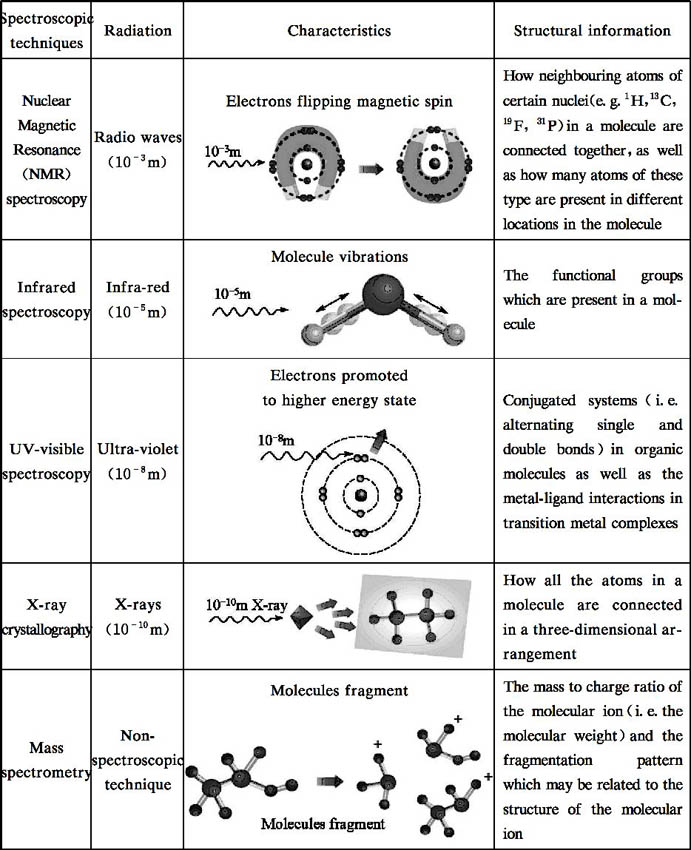- 有機化合物結(jié)構(gòu)分析=Structural Analysis of Organic Compounds:英文
- 江仁望主編
- 374字
- 2020-05-07 11:16:31
1.2 Major Spectroscopic Techniques
1.2.1 Absorption Spectrum
The energy states are said to be quantized because a photon of precise energy and frequency(or wavelength)must be absorbed to excite an electron or molecule from the ground state to a particular excited state.Since molecules have a unique set of energy states that depend on their structure,IR[28],UV-visible[29] and NMR spectroscopy[30] will provide valuable information about the structure of the molecule.
1.2.2 Diffraction
To “see” a molecule we need to use light having a wavelength smaller than the molecule itself(approximately 10-10m).Such radiation is found in the X-ray region of the electromagnetic spectrum and is used in the field of X-ray crystallography[31].This technique yields very detailed three-dimensional pictures of molecular structures-the only drawback being that it requires high quality crystals of the compound being studied.Although other spectroscopic techniques do not yield a three-dimensional picture of a molecule they do provide information about its characteristic features and are therefore used routinely in structural analysis.
1.2.3 Molecular and Fragment Spectrum
Mass spectrometry(MS)[32] is another useful technique used by chemists to help them determine the structure of molecules.Although sometimes referred to as mass spectroscopy it is,by definition,not a spectroscopic technique as it does not make use of electromagnetic radiation.Instead the molecules are ionised using high energy electrons and these molecular ions subsequently undergo fragmentation.The resulting mass spectrum contains the mass of the molecule and its fragments which allows chemists to piece together its structure.
Each technique can generate unique structure information.So in actual applications,all information from IR,UV-visible,MS and NMR spectroscopy are combined together.Sometimes,X-ray crystallography is use to figure out the new skeleton and stereochemistry.
In all spectroscopic techniques,only very small quantities(milligrams or less)of sample are required,however,in mass spectrometry the sample is destroyed in the fragmentation process whereas the sample can be recovered after using IR,UV-visible and NMR spectroscopy(Table 1-2).
Table 1-2 Characteristic and structure information of individual spectroscopic techniques
表1-2 各種波譜學(xué)技術(shù)的特征和結(jié)構(gòu)信息

- 區(qū)塊鏈技術(shù)基礎(chǔ)教程:原理、方法及實踐
- 現(xiàn)代信息管理
- 校園心理劇團體心理輔導(dǎo)與咨詢
- 大學(xué)生必讀的100本書
- 陶藝基礎(chǔ)與創(chuàng)作
- 2020年西藏自治區(qū)選調(diào)生考試《行政職業(yè)能力測驗》考點精講及典型題(含歷年真題)詳解
- 化學(xué)反應(yīng)器中的宏觀與微觀混合
- 國際物流與貨運代理
- 吳侃《高級日語1》學(xué)習(xí)指南【課文重點+詞匯剖析+語法精解+全文翻譯+練習(xí)答案】
- 外貿(mào)英文信函
- 生物化學(xué)基礎(chǔ)
- 黎詣遠《微觀經(jīng)濟學(xué)》(第4版)筆記和課后習(xí)題詳解
- 公共經(jīng)濟學(xué)
- 電商客戶關(guān)系管理(微課版·第2版)
- 2020年考研英語(一)閱讀理解高分特訓(xùn)100篇【命題分析+答題攻略+強化訓(xùn)練】